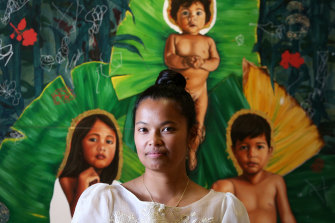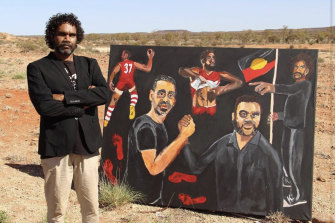Whether you're an avid gallery-goer or not, the Archibald Prize is an opportunity to see what's happening in Australian painting, and to consider how our institutions reflect who we are, individually and collectively.
For the second year running, the usual exhibition hang has been reversed. The Archibald portraits are now located in the final galleries at the Art Gallery of NSW, with visitors first greeted by the Sulman Prize entries, and then the Wynne Prize entries.
Marikit Santiago won the Sulman Prize with her work The Divine.Credit:Getty
The everyday and imagined scenes in the Sulman are a great way to get familiar with current painting trends, given the prize's relatively open brief. The variety of styles and moods here whets the appetite for what lies beyond.
The Wynne Prize showcases Australian landscape painting as well as figurative sculpture. As the possibility of another catastrophic summer looms and we emerge from behind our computer screens in a precariously controlled pandemic, the large scale of many of the Wynne works allows the viewer to become absorbed in landscape, in all its joy and terror.
As you move through the exhibition, it is worth remembering that the finalists and winners are chosen by the Art Gallery's trustees (except the Sulman Prize which is judged by a guest artist – Khadim Ali this year). The exhibition is a snapshot of their tastes, and debates about the winners demonstrate art's power to be a window to different world views.
Hubert Pareroultja’s Wynne-winning artwork, Tjoritja (West MacDonnell Ranges, NT). Acrylic on canvas, 183 x 244 x 4 cm. © the artist.
Anne Ryan, curator of the exhibition, notes there is increased diversity in this year's Archibald – a record number of Indigenous finalists (including Vincent Namatjira, the first Indigenous winner in the prize's 99-year history), and the inclusion for the first time of portraits by artists living with a disability. This diversity is "not just in terms of who the artist is, not even just in terms of what they're painting, but how they see the world".
There are familiar faces to be found and new ones to meet, from Maggie Tabberer to Adam Liaw, L-Fresh the Lion to Barry Jones. An insightful portrait requires deep connection between painter and sitter and many artists have painted well-known friends or fellow artists, while others opted for a self-portrait. The choice of sitter "tells you … what artists feel they are capable of doing in terms of getting a very true portrait," says Ryan.
The artists' aesthetic choices, from texture to scale, can only be truly experienced in person. While some artists splash a public persona on a large canvas, others have chosen a small, personal take.
Artist Vincent Namatjira with his Archibald Prize-winning portrait of himself and Adam Goodes.
"There's a lot of large portraits of assertive, often male presence," Ryan observes. "This is not uniform by any means, but a lot of the portraits of women are far more diminutive, quiet, soft… Sometimes a big picture is shouted down by a very quiet, small picture."
Don't miss:
Karen Black's portrait of the late artist Madonna Staunton uses colour and texture to express the complexities of her subject, an accomplished artist who was living with dementia at the end of her life. Black's brushstrokes draw the eye in and out of the painting's layered depths.
William Mackinnon's painting Sunshine and Lucky (life) captures the overwhelming experience of new parenthood, and how a woman's individual identity can get lost while caring for a newborn. Mackinnon's large-scale portrait of his partner breastfeeding their child holds its own among the many large-scale portraits of men on show.
Neil Tomkins and Digby Webster began painting each other separately but as their portraits progressed it became clear the works belonged together, united under the friends' shared middle name Ernest. Their powerful gazes, which would have originally been directed at each other, now compete for the viewer's attention.
John Ward Knox's detailed painting of New Zealand Prime Minister Jacinda is actually two paintings on translucent silk, suspended a few centimetres apart from each other within the frame. The images shift as the viewer moves, inviting observers into this informal moment around the kitchen table.
Kaylene Whiskey listens to the music of Dolly Parton while she paints, and Dolly visits Indulkana imagines the singer visiting Whiskey at her home in the Anangu Pitjantjatjara Yankunytjatjara (APY) Lands. The painting captures a party atmosphere, where dreams and reality collide in a buoyant expression of Whiskey's personality.
Most Viewed in Culture
Source: Read Full Article


